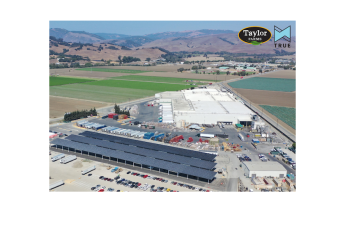Q&A: Agriculture Secretary Tom Vilsack on the USDA’s $300M investment in organics

The USDA is putting $300 million into a new Organic Transition Initiative aimed at helping to build new and better markets, as well as streams of income for farmers and producers.
On Aug. 22, Agriculture Secretary Tom Vilsack announced details of the USDA’s investment, which will include American Rescue Plan funds.
“Through this multiphased, multiagency initiative, we are expanding USDA’s support of organic farmers to help them with every step of their transition, as they work to become certified and secure markets for their products,” Vilsack said in a statement.
USDA’s Agricultural Marketing Service, Risk Management Agency and Natural Resources Conservation Service are the primary agencies supporting the initiative, which will focus on three areas, including a Transition to Organic Partnership Program, direct farmer assistance and organic pinpointed market development support.
In a phone interview with The Packer prior to the announcement, Vilsack provided background and additional details on the new initiative, which he says is the USDA’s second and “fairly significant” step in developing and advancing the U.S. market for organics.
The following has been edited for length and clarity.
Thank you for taking the time to speak with The Packer today.
Vilsack: First, I’d like to take a couple of minutes to sort of create the framework for this.
When we started this administration, the president was clear to us that he wanted to build a stronger and more vibrant economy, with a particular emphasis on creating a stronger middle class — from the bottom up and the middle out, as he likes to say. In the agricultural space, that means developing more, new and better markets for farmers so that they have additional opportunities to profit and to stay in business.
So, we focused on more exports. We focused on local and regional food systems, creating more processing capacity. We also have a pretty significant initiative on climate smart agricultural products that we're going to launch in September, but on the better market side, organic has a role to play.
It's obviously a higher-value proposition, and we know that we need more producers. We know that we need more market opportunities in the organic space, and we know that we need a better alignment of the supply of organic product and the demand that is out there.
The first step we took in this effort to bolster these better market opportunities through organic was to reduce the cost of certification. We launched an organic certification and transition cost share program that provided financial assistance with reference to the certification cost and the precertification inspection and planning costs.
We allocated roughly $20 million, and to date, 7,383 organic producers have benefited.
Today, we’re taking the second step if you will — a fairly significant step — in creating an Organic Transition Initiative, which is essentially designed to do three basic things: It's designed to provide wraparound technical assistance and farmer-to-farmer mentoring, so that those who are interested in becoming organic farmers can learn from those who already are; financial support for the costs that are involved in conservation and in risk management; and the development of adequate supply chains and market opportunities.
We're allocating $300 million to this initiative over the course of the next couple of years.
Mentorship and assistance
[Part of] what we hope to be able to do with this money is to develop six regional efforts where we create partnership networks with trusted local organizations that will provide the training, the education and the outreach that will allow this mentoring program to be established for new and beginning farmers in the space.
We expect and anticipate that these partnerships will provide technical assistance across a fairly broad array of topics — conservation, business development, regulations, marketing, agronomy and things of that nature — and we're going to make sure that this isn't just for the haves. We're also going to make sure that those who are unserved or underserved are able to be part of this effort, as well.
We will complement this regional, hands-on wraparound technical assistance effort with an online presence, where USDA will create an online Organic Assistance Resource Center, so folks can get information when needed. Roughly $100 million of the $300 will be allocated for that purpose.
The second purpose is to provide more conservation and crop insurance support. We'll provide assistance on the crop insurance side to make it more affordable, allocating roughly $25 million to that purpose. NRCS is establishing a new practice standard, and so there'll be a roughly $70 million available for compliance and to allow that standard to be implemented.
Another $5 million will go to organic experts located at each one of these centers and a national coordinator who will oversee these efforts. So that's roughly $100 million in creating direct support for conservation crop insurance. The balance will be allocated over time.
The bottom line of this is to encourage more participation in organic production, which not only has the benefit of a higher-value proposition, but also, obviously, has a fairly significant climate benefit, as well.
So, this initiative is a really good opportunity to advance two of the administration's big issues: increasing the middle class and making our country more climate smart.
You mentioned that these efforts will be implemented over the next several years. Is there a specific time frame for these investments? How long do you anticipate it will take to implement all aspects of the initiative?
The expectation is certainly that all three pieces will be implemented over the next year or so. Then the hope would be that, as people see the importance and success of it, and as Congress considers the farm bill, it figures out a way in which these kinds of initiatives can be become a more permanent fixture of the department as opposed to a one-off process.
According to the USDA National Agricultural Statistics Service, the number of noncertified organic farms actively transitioning to organic production dropped by nearly 71% since 2008. To what do you attribute this significant decline? And what do you see as some of the core strengths of the Organic Transition Initiative in reversing this trend?
I think a lot of it has to do with the costs associated with it and the paperwork, as well as the challenges that you have to overcome as a small producer. That's the reason why we first established the certification systems program that I mentioned earlier. Obviously, 7,383 producers have taken advantage of that, so I think you're going to see reversal over time because we're providing the financial assistance to make it a bit easier to get certified.
And I think this transition program is going to make it much easier for farmers because they can link up with a more experienced organic producer who can take them through the process.
What aspects of the initiative do you anticipate being most beneficial to growers of fresh fruit and vegetables?
I think all aspects of this are going to be important to fruit and vegetables because there's a demand for it. Through this initiative, we hope to encourage farmers to get in this business by making it easier for them, where they can learn from the mistakes of more experienced organic producers; by making sure that the cost of crop insurance is not prohibitive; and by helping them with the cost of certification so that it becomes less of a financial strain.
Do you see the Organic Transition Initiative driving consumer demand for organic products?
Well, I don't know that it'll drive consumer demand. I think it will respond to the demand that will be driven based on the organic industry's ability to market to consumers. This isn’t necessarily a marketing initiative on the part of the Department of Agriculture. It is, instead, a recognition that there is demand — that there is an opportunity here to create a better market, a higher-value proposition for producers if they wish to participate. And I think, to the extent that we are able to produce more and better alliances in supply and demand, it will make a better and stronger market, which should encourage more consumer participation.
This is a comprehensive program with multiple agencies in participation. In terms of the design of the initiative, what do you think will be the key to its success?
That's not an easy question to answer because I think you obviously have to have a market in order for people to participate. That's incredibly important, but if you have a market but you don't have enough producers, or producers feel that the hill is too steep to climb because they don't understand how to get started, then that’s a challenge. So, that's the whole purpose of this comprehensive approach. It's essentially addressing the challenge of, how do I start this? How do I do it?
Well, now you're going to be paired with a mentoring farmer who can say, ‘Look, this is how I started and, boy, I wish I could have done it differently based on what I now know. And here's what I would encourage you to do.’
I think, really, it's the comprehensive and coordinated nature of this approach that will be the key to its success. It isn't necessarily one component. It's the fact that you've got all three areas of focus working and aligned toward the goal of increasing production and increasing the number of producers, as well as gaining the financial and climate benefits.







